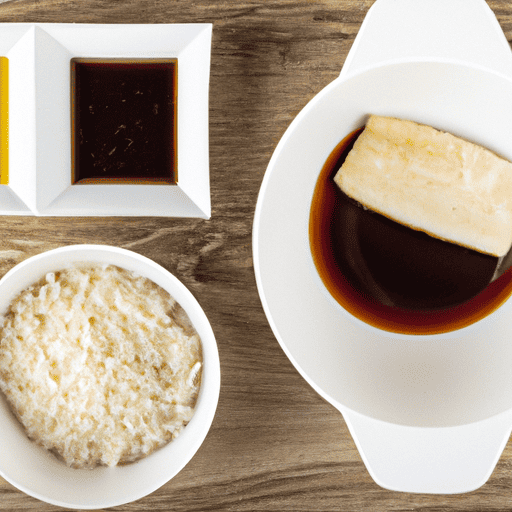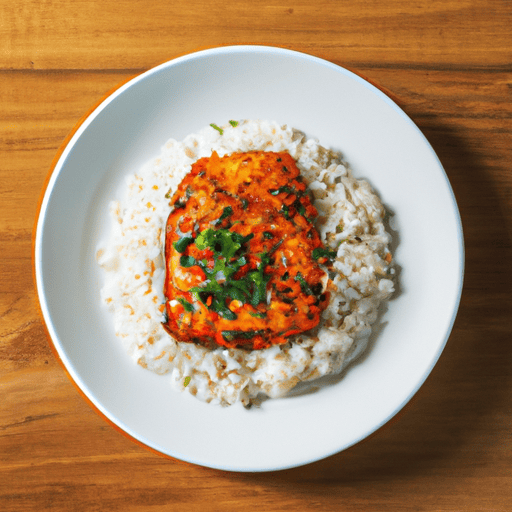Hello and welcome to Rice Cookers 101! Today, we will be sharing with you one of the most flavorful and delicious Korean recipes, Halibut Rice. This dish is a perfect combination of tender halibut and fluffy rice, all infused with a medley of aromatic spices and seasonings. With the help of your trusty rice cooker, this recipe is simple to make and guaranteed to impress your taste buds. So let’s dive in and learn how to make this scrumptious and healthy dish! We’ve made this korean halibut rice recipe easy to follow 👨🍳. If you’re looking for our favorite rice cookers to make this recipe, check out our list of top rice cookers here.

Ingredients
- 1 lb. halibut fillet
- 2 cups uncooked short-grain rice
- 3 cups water
- 1 tablespoon soy sauce
- 1 tablespoon mirin
- 1 tablespoon honey
- 1 tablespoon sesame oil
- 1/4 teaspoon black pepper
- 2 cloves garlic, minced
- 1/2 onion, chopped
- 1/2 carrot, chopped
- 1/2 zucchini, chopped
- 1/2 red bell pepper, chopped
- 4 green onions, sliced
- 1 tablespoon vegetable oil
Instructions
- Rinse the rice in a fine mesh strainer and add it to a medium-sized pot with 3 cups of water. Bring it to a boil, then reduce the heat to low, cover the pot, and simmer for 15-20 minutes or until the rice is cooked.
- In a small bowl, whisk together the soy sauce, mirin, honey, sesame oil, black pepper, and minced garlic.
- Heat a large skillet over medium-high heat and add the vegetable oil. Once it’s hot, add the chopped onion and cook for 2-3 minutes or until it starts to soften.
- Add the chopped carrot and cook for another 2-3 minutes.
- Add the chopped zucchini and red bell pepper and cook for another 2-3 minutes or until the vegetables are tender-crisp.
- Add the sliced green onions and halibut fillet to the skillet and cook for 1-2 minutes per side or until the fish is cooked through.
- Pour the soy sauce mixture over the fish and vegetables and stir everything to coat.
- Serve the halibut and vegetables over the cooked rice, garnished with additional sliced green onions if desired.
First, rinse the rice in a fine mesh strainer and add it to a medium-sized pot with 3 cups of water. Bring it to a boil, then reduce the heat to low, cover the pot, and simmer for 15-20 minutes or until the rice is cooked. In a small bowl, whisk together the soy sauce, mirin, honey, sesame oil, black pepper, and minced garlic. Heat a large skillet over medium-high heat and add the vegetable oil. Once it’s hot, add the chopped onion and cook for 2-3 minutes or until it starts to soften. Add the chopped carrot and cook for another 2-3 minutes. Then, add the chopped zucchini and red bell pepper and cook for another 2-3 minutes or until the vegetables are tender-crisp. Add the sliced green onions and halibut fillet to the skillet and cook for 1-2 minutes per side or until the fish is cooked through. Pour the soy sauce mixture over the fish and vegetables and stir everything to coat. Finally, serve the halibut and vegetables over the cooked rice, garnished with additional sliced green onions if desired. 
How long does korean halibut rice last in the fridge?
Korean halibut rice can be stored safely in the fridge for up to four days after cooking. To ensure maximum freshness and prevent bacterial growth, it is important to cool the dish quickly before storing in an airtight container. Reheating the rice thoroughly before consuming is also recommended to eliminate any potential foodborne illness. If you’re planning to store the rice in the freezer, it can last for up to two months with proper freezing techniques. Make sure to consume the rice within a reasonable timeframe to avoid any food spoilage and always follow safe food handling practices.
Low calorie korean halibut rice recipe substitutions
To make this recipe lower in calories, some substitutions can be made. For the halibut, it can be replaced with a leaner white fish, such as tilapia or cod. Additionally, the amount of oil used can be reduced or replaced with a non-stick cooking spray. Instead of honey, a natural sweetener like stevia or agave can be used. The amount of rice can also be reduced, or replaced with a low-carb alternative like cauliflower rice. Finally, for the vegetables, a variety of low-calorie options can be used, such as mushrooms, asparagus, or snap peas. By making these substitutions, the Korean halibut rice recipe can be made lighter and more diet-friendly without sacrificing flavor.
What to serve with a korean halibut rice?
Korean halibut rice is a delicious and flavorful dish that pairs well with a variety of sides. One popular option is kimchi, a traditional Korean side dish made from fermented vegetables such as cabbage or radish. Additionally, steamed or stir-fried vegetables such as bok choy, snow peas, or carrots complement the dish well. For a more substantial meal, consider serving the halibut and rice alongside a traditional Korean soup such as doenjang jjigae or miyeok guk. Finally, a refreshing cucumber or seaweed salad is light and refreshing and will balance out the rich flavors of the dish.
Whats the best sauce for a korean halibut rice?
Korean halibut rice is a delicious and nutritious dish that can be enhanced with the right sauce. One option is the traditional gochujang, which is a slightly sweet and spicy sauce made with fermented soybeans and red pepper paste. This sauce perfectly balances the mild flavor of the halibut and complements the rice and vegetable ingredients. Another option is a soy-based sauce, which provides a salty and savory flavor that enhances the umami taste of the dish. Whichever sauce you choose, be sure to mix it well with the rice and halibut to fully enjoy all the different flavors and textures of this dish.
Korean halibut rice health benefits
Korean halibut rice is a dish that contains many health benefits. Halibut is an excellent source of protein and omega-3 fatty acids, which are essential for heart health and brain function. The rice provides a good source of carbohydrates which are important for energy production. Additionally, the dish usually contains vegetables such as carrots and green onions, which add fiber and vitamins to the meal. Overall, Korean halibut rice is a nutritious and delicious dish that can contribute to a balanced and healthy diet.If you are looking for an alternative recipe that is even healthier, you could consider making a vegetable and tofu stir-fry. This dish is low in fat and calories, and high in fiber and vitamins. Tofu is an excellent source of plant-based protein and can easily be incorporated into many dishes. The stir-fry can also contain a variety of colorful vegetables such as bell peppers, broccoli, and carrots, which add a variety of beneficial nutrients to the meal. Overall, a vegetable and tofu stir-fry is an easy and delicious way to get your daily dose of vegetables and fiber.

